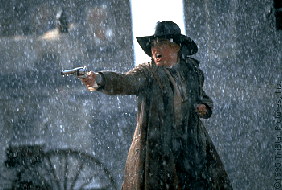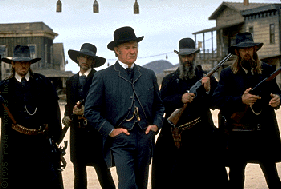Cinematic Pleasures: The Quick and the Dead
by j.d. lafrance
 Ever since Clint Eastwood's film Unforgiven (1992), the Western has enjoyed a lucrative revival in Hollywood. That film's success paved the way for a whole slew of new takes on the genre from the traditional (Tombstone) to the gimmicky (Posse), with homages to all the old masters - most notably John Ford. However, no one has tried to pay tribute to Sergio Leone and his colourful "Spaghetti Westerns" (with the exception of Alex Cox's surreal ode, Straight to Hell) that were wild, often surreal explorations of the Western genre. No one that is, until Sam Raimi's film, The Quick and the Dead (1995) was released. Raimi, best known for turning the horror genre upside down with his Evil Dead trilogy, is the best person to re-visit the "Spaghetti Western." Like Leone, Raimi is not afraid to inject his own unique style into a film with the intention of breathing new life into a tired genre. Leone did this first with the Western and later, the Gangster film, while Raimi chose the horror film before then tackling the Western. The result: The Quick and the Dead is a playful, entertaining film that doesn't aspire to do anything more than take the viewer on a thrilling ride.
Ever since Clint Eastwood's film Unforgiven (1992), the Western has enjoyed a lucrative revival in Hollywood. That film's success paved the way for a whole slew of new takes on the genre from the traditional (Tombstone) to the gimmicky (Posse), with homages to all the old masters - most notably John Ford. However, no one has tried to pay tribute to Sergio Leone and his colourful "Spaghetti Westerns" (with the exception of Alex Cox's surreal ode, Straight to Hell) that were wild, often surreal explorations of the Western genre. No one that is, until Sam Raimi's film, The Quick and the Dead (1995) was released. Raimi, best known for turning the horror genre upside down with his Evil Dead trilogy, is the best person to re-visit the "Spaghetti Western." Like Leone, Raimi is not afraid to inject his own unique style into a film with the intention of breathing new life into a tired genre. Leone did this first with the Western and later, the Gangster film, while Raimi chose the horror film before then tackling the Western. The result: The Quick and the Dead is a playful, entertaining film that doesn't aspire to do anything more than take the viewer on a thrilling ride.
Essentially a series of shoot-outs, The Quick and the Dead distracts us from this simple concept with a twisted tale of revenge. Enter a mysterious woman (Sharon Stone) who is not only quick with her gun but with her snappy comebacks to snide remarks. She soon finds herself in the sorry excuse of a town named Redemption (you can almost cut the symbolism with a knife) conveniently before the start of its annual quick draw contest.
The competition throws all sorts of colourful characters into the mix: from Ace Handlen (Lance Henrikson), a preening card player and a crack shot, to The Kid (Leonardo DiCaprio), a young upstart who is as cocky as he is fast with a gun. To make the whole spectacle a little more interesting, the town's sheriff forces Cort (Russell Crowe), a lethal killer who used to ride with the lawman, into the contest. Cort has given up killing and turned into a repentant preacher. His lack of bloodlust adds a bit of variety to the proceedings. The contest is run by the town's sheriff, John Herrod (Gene Hackman), a truly evil man who delights in keeping the town under his tyrannical boot heel. It soon becomes apparent, however, that the contest is not the only reason that Stone's character has arrived in this town. The competition serves as a convenient excuse for Stone's character to exact a little revenge and also for us to watch all of these wild personalities square off against one another.
The Quick and the Dead was a refreshing change of pace for filmmaker Sam Raimi. He had just survived an exhausting and often frustrating battle with Universal Studios over Army of Darkness (1993), the last film in his Evil Dead trilogy. His budget had been cut back considerably, to the point where Raimi and the film's star, Bruce Campbell, were forced to use their own money to finish the film. To make matters worse, critics and audiences alike subsequently panned Army of Darkness. Raimi viewed his new project as a way of putting this horrendous experience behind him.
But he was not the first choice to direct The Quick and the Dead. Simon Moore, a British screenwriter, wrote the script and intended to direct the film himself. However, the film's producers had other ideas when actor Sharon Stone came on board as one of the stars and a co-producer as well. She was great admirer of Raimi's work and recommended him as director of the film. "He was the only person on my list. If Sam hadn't made this movie, I don't think I would have made it."
 Raimi accepted the job for a number of reasons. Up until that time, he had always been known primarily as an independent filmmaker working outside of the system. Raimi viewed this new project as his first Hollywood film with big name stars. "So it was time to see what it would be like to make a big Hollywood movie. It had always been a dream of mine, but I'd never done it." On another level, he saw this film as his homage to one of the masters of the Western, Sergio Leone. No one, in recent memory, had attempted to pay tribute to this particular filmmaker and Raimi thought it was about time that someone did. As he commented in an interview with Cinescape magazine, "the current genre cycle, the 'Spaghetti Western,' which was Leone's cheesier, less-classy version of the big studio Western, hasn't really been re-explored. This script really hit upon that, updating it with a female lead and a different set of values."
Raimi accepted the job for a number of reasons. Up until that time, he had always been known primarily as an independent filmmaker working outside of the system. Raimi viewed this new project as his first Hollywood film with big name stars. "So it was time to see what it would be like to make a big Hollywood movie. It had always been a dream of mine, but I'd never done it." On another level, he saw this film as his homage to one of the masters of the Western, Sergio Leone. No one, in recent memory, had attempted to pay tribute to this particular filmmaker and Raimi thought it was about time that someone did. As he commented in an interview with Cinescape magazine, "the current genre cycle, the 'Spaghetti Western,' which was Leone's cheesier, less-classy version of the big studio Western, hasn't really been re-explored. This script really hit upon that, updating it with a female lead and a different set of values."
What could have been just another novelty twist on the Western is transformed by Raimi's Gonzo style into a slick film filled with dramatic slow motion shots, adrenaline-fueled zooms and tracking shots with unusual perspectives, and extensive usage of deep focus photography that resembles a demented Orson Welles on speed. This rather showy excess of style playfully sets the tone of the film between parody and seriousness to the point where you are never quite sure which side of the fence the film is on. This was Raimi's intention from the beginning as he saw this extravagant approach "as entertainment for the audience. This is a fun, entertaining Western for a '90s crowd."
In what is fundamentally a picture built around a series of shoot-outs, Raimi keeps things fresh and exciting by filming each significant showdown in a different style. Raimi's wild approach also gives The Quick and the Dead an almost surreal quality: we get an unusual perspective shot through a huge bullet hole left in one gunslinger's head that seems almost cartoonish in nature. The bad guys are photographed at dramatically low angles as they chew up the scenery with their sneering, dirty looks and obvious contempt for anything decent. Pathetic fallacy also plays a large role in the film. When a fierce storm of Biblical proportions hits the town, sure enough something rotten is bound to happen. Of course this all seems like some sort of pat cliché, but there is a playful quality and chutzpah on Raimi's part to use every camera trick and technique in the book, that gives the film real charm and makes it worth watching.
Another reason why this film is so watchable lies in the fine group of actors that assembled to make this film. It is a good blend of big name, marquee value stars like Sharon Stone, Leonardo DiCaprio, and Gene Hackman, mixed with strong character actors like Lance Henrikson and then unknown Russell Crowe. Even though most critics admired Sharon Stone's turn as a no-nonsense gunslinger who ably holds her own against any man, Russell Crowe's tortured killer turned preacher is the real standout performance of the film. You can almost feel the pain and frustration boiling inside Cort as Herrod forces him to kill time and time again, even though he has renounced his violent ways. Crowe does not have nearly the amount of screen time that Stone, DiCaprio or Hackman have, but he makes every scene that he is in count by playing against type - his character is quiet and reserved when everyone else threatens to go over the top with their performances.
The Quick and the Dead may not have anything profound to say about the human condition but so what? That is not the film's goal. It serves as a piece of escapism, to make one forget about the problems of the real world and enter a fantastic realm filled with vivid characters and exotic locales that only the power of film can deliver. And on that level, The Quick and the Dead is a success.
Copyright (c) 2005 erasing clouds |
|